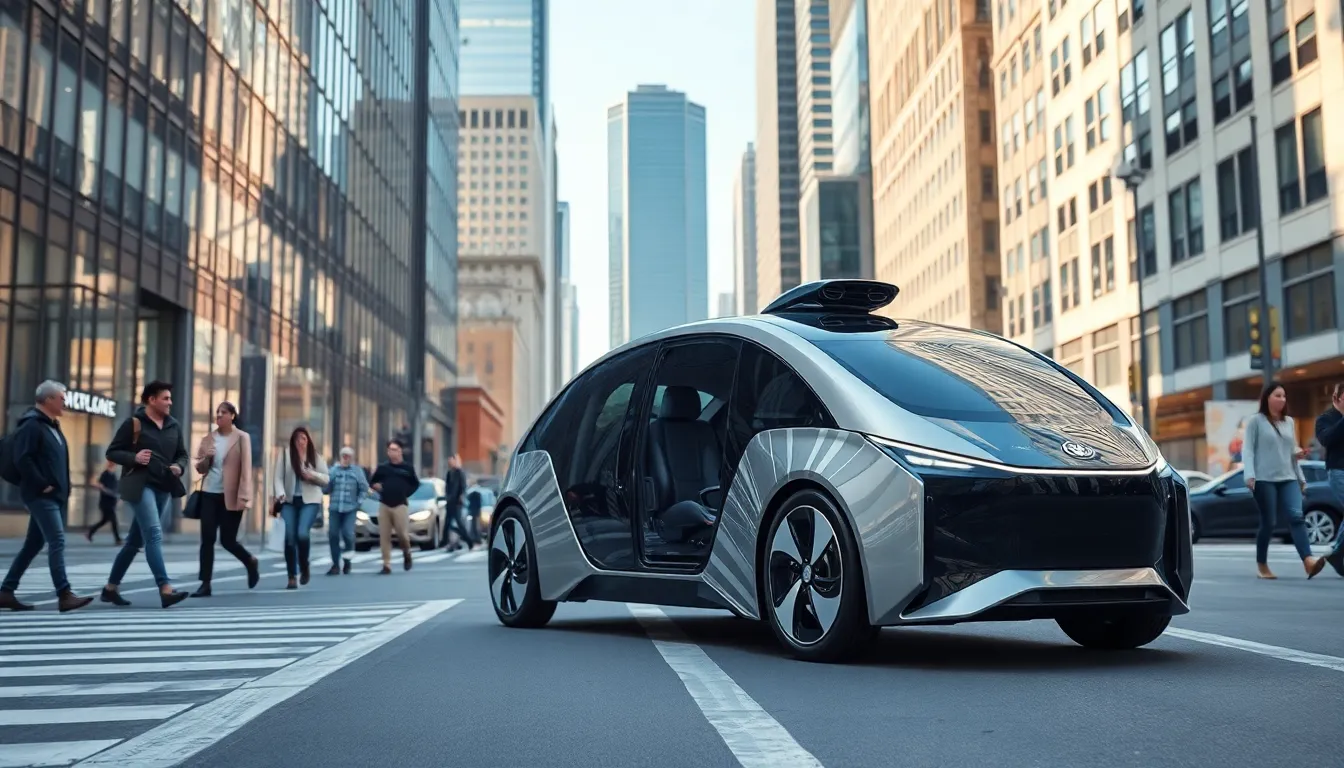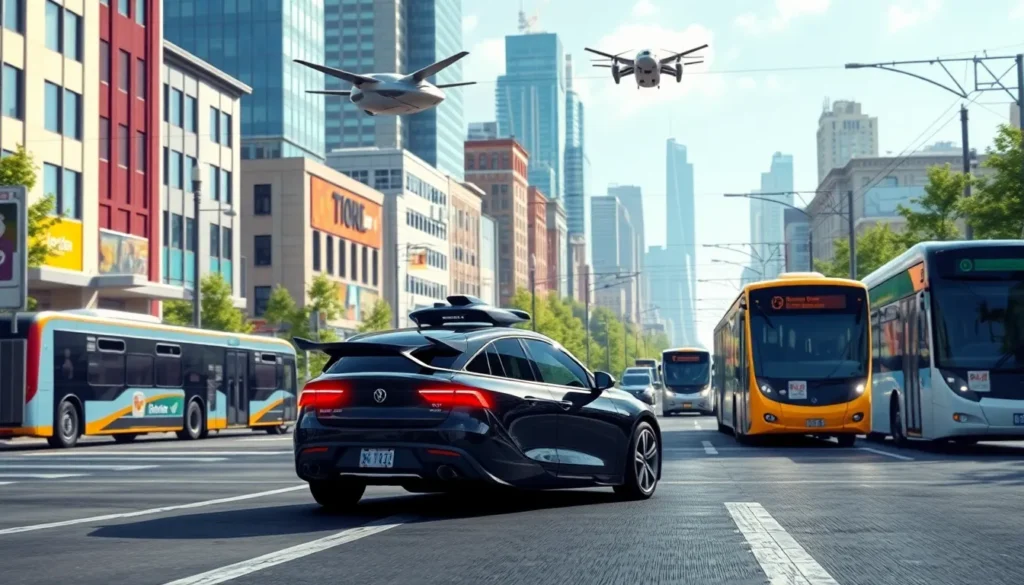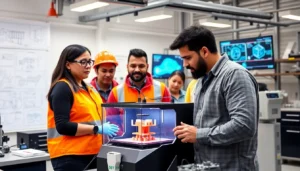Table of Contents
ToggleTransportation is on the brink of a revolution, and it’s about time! With emerging technologies reshaping how people and goods move, the future looks not just exciting but downright exhilarating. Imagine hopping into a self-driving car that knows your favorite playlist or zipping across town in a flying taxi while sipping your morning coffee. Sounds like a sci-fi movie, right? Well, buckle up because this ride is just getting started.
Overview of Emerging Technologies in Transportation
Emerging technologies in transportation reshape how people and goods move. Self-driving vehicles represent a significant development, offering increased safety and efficiency on the roads. These autonomous cars utilize advanced sensors and machine learning algorithms to navigate complex environments. Similarly, flying taxis introduce a new aerial dimension to urban mobility, promising faster travel times and reduced congestion.
Electric vehicles (EVs) continue to gain traction, driven by advancements in battery technology. Improved range and faster charging options make EV usage more practical for consumers. Public transportation also sees transformation with electric buses and trams. These sustainable options minimize emissions and contribute to cleaner urban air quality.
Hyperloop systems represent another innovative idea in high-speed travel. These systems use magnetic levitation technology to achieve speeds exceeding 700 mph. Not only do they reduce travel time between cities, but they also offer a more energy-efficient option for long-distance journeys.
Drones are increasingly utilized for cargo delivery, providing a swift alternative to traditional logistics. Companies are exploring this technology to expedite delivery services, particularly in urban areas. Integrated smart infrastructure further enhances the transportation landscape, utilizing connected devices to optimize traffic flow and enhance safety.
Regulatory frameworks must adapt to these emerging technologies. Policies supporting research and development will enable quicker adoption of these advancements. Ultimately, the fusion of these technologies creates exciting opportunities for the future of transportation, promising a seamless and efficient mobility experience for all.
Impact of Autonomous Vehicles

Autonomous vehicles stand at the forefront of transportation innovation, promising to reshape the future of travel. These self-driving systems can create significant changes in safety, efficiency, and environmental impact.
Benefits of Self-Driving Cars
Safety gains rank as a primary advantage of self-driving cars. Advanced sensors and machine learning algorithms reduce human error, which is responsible for over 90% of traffic accidents, according to the National Highway Traffic Safety Administration. Efficiency follows closely behind; autonomous vehicles optimize traffic patterns and reduce congestion, leading to shorter travel times. Environmental benefits emerge through decreased emissions due to efficient driving patterns and the potential integration with electric vehicle technology. Accessibility also improves for individuals unable to drive, such as the elderly and disabled, enhancing mobility and independence.
Challenges Faced by Autonomous Technology
Despite the promising potential, several challenges hinder widespread adoption of autonomous vehicles. Regulatory hurdles pose significant obstacles. Varying laws across states complicate the deployment of self-driving technology. Public perception represents another barrier; many individuals express skepticism regarding the safety and reliability of autonomous systems. Technological limitations exist; challenges remain in navigating complex urban environments and adverse weather conditions. Additionally, cybersecurity threats can undermine trust in these systems, posing risks of hacking and data breaches. Solving these issues is crucial for realizing the full benefits of autonomous vehicles.
Electric and Hybrid Vehicles
Electric and hybrid vehicles represent a major shift in transportation, showcasing a commitment to sustainability and cleaner energy sources.
Environmental Benefits
Electric vehicles produce zero tailpipe emissions, significantly reducing air pollution in urban areas. Hybrid vehicles combine conventional engines with electric systems, enhancing fuel efficiency and minimizing environmental impact. According to the International Energy Agency, EVs can reduce greenhouse gas emissions by up to 70% over their lifetime compared to traditional gasoline cars. Countries embracing EVs often see improvements in local air quality, leading to better health outcomes for residents. Investing in this technology contributes to global efforts against climate change and drives down dependence on fossil fuels.
Innovations in Battery Technology
Recent breakthroughs in battery technology have propelled electric vehicles towards mainstream adoption. Solid-state batteries, offering higher energy density, lead to longer ranges and faster charging times. Lithium-ion batteries dominate the market, but emerging alternatives showcase promising potential. For instance, researchers are exploring sodium-ion batteries which may provide lower costs and enhanced availability of raw materials. Studies indicate that advancements in battery recycling could lead to a circular economy for EV components, minimizing waste. As manufacturers refine battery technologies, the focus shifts toward creating more efficient, durable, and environmentally friendly solutions.
Smart Transportation Systems
Smart transportation systems leverage technology to enhance urban mobility while improving safety and efficiency. By integrating advanced systems, cities can transform the travel experience.
Integration of IoT in Transportation
IoT technology plays a vital role in transportation by connecting vehicles, infrastructure, and users. Smart sensors facilitate real-time data exchange, allowing for more efficient traffic management and improved public transport services. For instance, cities use connected traffic signals to optimize flow based on real-time traffic conditions. Drivers receive timely updates on traffic patterns, reducing delays and enhancing route efficiency. The integration of IoT also supports fleet management, enabling companies to monitor vehicle performance and environments continuously. Utilizing this data fosters predictive maintenance, ultimately decreasing operational costs and improving service quality.
Enhanced Traffic Management Solutions
Innovations in traffic management solutions address congestion and improve safety on roadways. Advanced algorithms analyze data from connected vehicles and infrastructure to predict traffic patterns, allowing for timely interventions. Smart traffic lights adapt to current traffic conditions, minimizing wait times for drivers and pedestrians. Moreover, various cities implement adaptive traffic signal control systems, which optimize signal timings based on real-time traffic flow. These solutions lead to a reduction in emissions by preventing idling and improving overall air quality. Such advanced management tools ensure that urban areas can accommodate growing populations while maintaining efficient transportation networks.
Emerging Modes of Transportation
Emerging transportation technologies are reshaping how people and goods move. Innovations like the hyperloop and drones offer unprecedented possibilities for efficient travel and delivery.
Hyperloop and Its Potential
Hyperloop systems promise to transform long-distance travel with speeds exceeding 700 mph. This groundbreaking technology utilizes magnetic levitation to create a near-frictionless environment, ultimately minimizing travel time between cities. According to industry studies, hyperloop could reduce a two-hour trip by train to mere minutes. Investments in this technology have surged, driven by the potential to revolutionize public transport. Countries like the United States, India, and several European nations are actively exploring hyperloop development, indicating a strong interest in this high-speed transportation mode.
Drones for Delivery and Transport
Drones are rapidly becoming a key player in logistics and delivery services. With the ability to navigate directly to destinations, these unmanned aerial vehicles can dramatically cut delivery times. Major companies like Amazon and UPS are already testing drone delivery systems, aiming to provide same-day service for lightweight packages. The Federal Aviation Administration projects that by 2025, the commercial drone market will grow to $29 billion, emphasizing the lucrative opportunities in this sector. Drones also support deliveries in urban areas, helping to alleviate road congestion and reduce the environmental impact of traditional delivery vehicles.
The future of transportation is poised for a remarkable transformation driven by innovative technologies. As self-driving vehicles and flying taxis emerge, they promise to redefine mobility in ways that enhance safety and efficiency. Electric and hybrid vehicles are paving the way for a cleaner environment while breakthroughs in battery technology support their widespread adoption.
The rise of drones for delivery and advancements in smart transportation systems further illustrate the potential for a seamless urban experience. While challenges remain, including regulatory hurdles and public acceptance, the ongoing commitment to innovation indicates a future filled with exciting possibilities. Embracing these changes will not only improve mobility but also contribute to a sustainable and efficient world.







